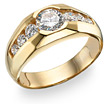 History of Gold (continued)
History of Gold (continued)

In 58 BC, after his successful
Gallic campaign, Julius Caesar brought back enough gold to present every man in
his army with 200 coins. With the remainder, he was able to payback all of
Rome's debts.
In the 8th century, Charlemagne
conquered the eastern European Avars. In doing so, he also captured their vast
quantities of gold, which aided him greatly in becoming the first Holy Roman
Emperor and to be popularly perceived as the Father of Europe.
In the 13th century, the Republic of
Venice introduced the gold 'ducat'. It remained the most popular trade currency
in Europe for over 500 years.
In the 1500s, King Ferdinand of
Spain charged his explorers, who were setting out toward the Western Hemisphere,
to get gold. They were to do this humanely if possible, but to get gold
nonetheless.
In 1787, New York silversmith
Ephraim Brasher struck the first gold coin in America. It was a doubloon bearing
the American eagle and shield next to his initials. It also bore the reversed
national motto, "Unum e pluribus" (One From the Many), and the date 1787.
Between 1789 and 1804, gold was discovered in North Carolina – including a
17-pound nugget in Cabarrus County. From then until 1828, North Carolina
supplied all the domestic gold coined by the Philadelphia mint.
In 1848, while building a sawmill for John Sutter near Sacramento, California,
John Marshall discovered some flakes of gold at the location. The Gold Rush of
'49 was about to begin.
In 1897, a small group of prospectors struck gold along the Klondike River in
Yukon Territory, Canada. News of the strike precipitated a frenzy of over
100,000 stampeders to the area in hopes of striking it rich.
Next:
Rising Gold
Demand
Page
1
2 [3]
4
5

14K Solid White Gold Curb
Bracelet

14K Solid White Gold Mariner
Bracelet
Related Article:
Rising Price
of Gold and Retail Jewelry
Pricing Gold
Chains